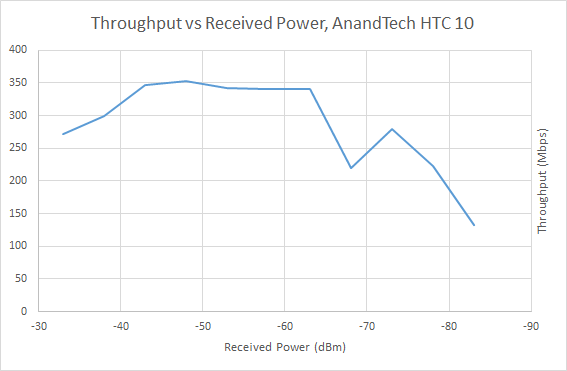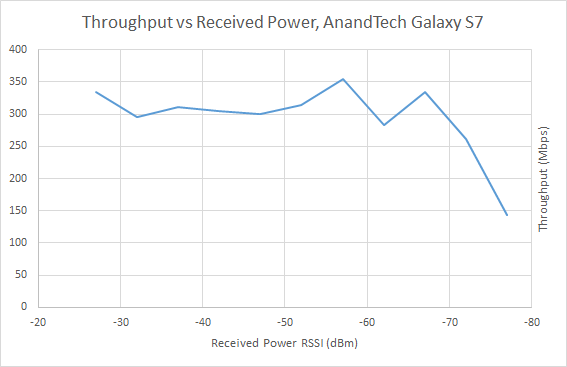The Samsung Galaxy S7 and S7 edge Review: Part 2
by Joshua Ho on July 5, 2016 8:00 AM ESTWiFi Testing with Ixia IoT
As previously discussed, RF testing has always been a major unknown to some extent because environmental factors make it extremely difficult to tell exactly what is going on with the system. I don’t think it really needs to be said but previous reviews and any controversy regarding the quality of RF has always lead to a ring of confusion and back and forth with no clear-cut answers, at least in the public domain. The Transformer Prime and Pixel C reception issues have all been cases where I’ve seen a lot of confusion over whether a problem really existed in the hardware, software, or with the end user.
Most people really don’t have any understanding of how wireless transmission works, probably because it’s not really something you can see. As far as I know, no one is capable of seeing radio waves, even at high frequencies like 60 GHz. Of course, the problem is that for quite some time our testing was also not really ideal for seeing the quality of an RF implementation. While iPerf does provide some useful data, free space testing means that we’re dealing with channel conditions that inherently cannot be controlled. As a result, the only sensible test we could do with iPerf was focus on maximum throughput in the best conditions we could provide. The only thing that this can highlight is the upper bound of efficiency for WiFi due to the carrier sense multiple access scheme in most cases, and rarely detects a whole class of problems that affect user experience on WiFi.
In order to test these things we’ve moved to using a proper testing system that is actually used by at least a few OEMs today, namely Ixia IoT. While we discussed the possibilities for testing, at this time due to the RF isolation chamber used we are limited to AP simulation only, so we can’t properly simulate clients in the channel without restricting ourselves to a single spatial stream for both the AP and client. This wouldn’t be a very useful test if set up in this manner as most devices today that we’re testing have support for two spatial streams, and many routers have three or even four spatial streams at this point.
The first set of results we can talk about that will be of interest is rate vs range. This is a fairly simple test at a conceptual level, as it simply tries to see how well a device can maintain its performance in the face of reducing signal to noise ratio for a given modulation and coding scheme. This is a good high level test of how well a device can maintain a connection as reception degrades. In this test the HTC 10 had an initial RSSI of -28 dBm while the GS7 was at -21 dBm and the iPhone 6s at -22 dBm, which allows us to calculate the path loss and determine the RSSI as a function of the transmit power.
The results of this test are interesting to say the least. Off the bat, every device had different RSSIs measured, so this meant that everything had different levels of path loss. The HTC 10 seemed to have the most path loss, while the Galaxy S7 and iPhone 6s were functionally identical. However it looks like RSSI is really an insufficient metric here because while the iPhone 6s was able to reach maximum throughput using NSS 2 MCS 8, the HTC 10 and Galaxy S7 did its best at NSS 2 MCS 4 or 5. I suspect this may be just due to placement as device positioning strongly affects MIMO as receive-side spatial correlation reduces the gains that MIMO can provide. Regardless, the HTC 10 somehow manages to beat the Galaxy S7 through much of the curve, but for some reason suffers from a reduction in throughput at higher transmit power. It's worth mentioning though that this test doesn't allow for testing of antenna gain or similar tests. Given various levels of futzing about with the device positioning in the test chamber I'm fairly confident that the Galaxy S7 is consistently better with regard to path loss, so even if it doesn't perform as well at a given RSSI it tends to have a higher RSSI than the HTC 10 by about 5 dBm which is fairly significant.
Finally, the other test that we can run at this time is the roaming latency test, which tests how well a device can hop from one access point to another as the received transmit power rises and falls. If you ever rely on WiFi to work as you walk around any building larger than a single apartment unit, you’re going to feel the effects of high roaming latency as VOIP calls or any real-time network application will either experience interruption or drop altogether if roaming is not implemented properly.

In the case of the Galaxy S7, roaming latency is honestly rather wanting. In the best case the Galaxy S7's roaming latency appears to be acceptable, but it's still significantly worse than the best we've seen so far. It seems that Samsung's algorithms have issues with edge cases as I've seen multiple instances so far where the device just can't handle roaming consistently. Despite consistent positioning and identical test setup I've seen cases where the Galaxy S7 has problems with consistent roaming. Even with the simple case of 10 dBm to -45 dBm at 3 dBm drop per second, I've encountered weirdness where the device drops from the network altogether claiming that the password given was incorrect (it wasn't) or a few successful handovers followed by getting stuck on a single access point or dropping from the network entirely. Even in the best set of trials performed I still saw 3 of 64 trials fail to roam correctly. The performance is certainly far better than something like the Google Pixel C, but Samsung should really be focusing on improving here.













266 Comments
View All Comments
virtuastro - Wednesday, July 6, 2016 - link
Exactly. My friend bought the S7 for the camera. We tested together between the S6 16mp F/1.9 (my phone) and S7 F/1.7 12mp 1.4 µm. Autofocus is indeed faster on S7 than the S6. Still Image quality and Low-Light still better on S6 for the most part. The LG G4 and G5 both still use 16mp and great in low-light as well. I am not going to upgrade GS7 but waiting for next year. Hopefully Samsung need to back at 16mp F/1.7 to F/1.9 might add more faster autofocus. P.S. English is not my first language.lilmoe - Wednesday, July 6, 2016 - link
Provided sensor technologies are similar, the size of individual photosites don't matter really, what ultimately matters is the size of the sensor (the total amount of light captured) and the speed of the lens.Lower resolution images are better for faster and more fine-tuned post processing.
Impulses - Thursday, July 7, 2016 - link
Buying any high end phone largely on the basis of it's camera, particularly if you already have a decent 1-2 yr old flagship phone, is a huge waste of money IMO. The same kind of money gets you so much more in a dedicated camera, whether it's a P&S, DSLR, or compact mirrorless ILC.Smartphones killed low end small sensor P&S cameras, that market was essentially gutted (and with good reason as it was quite stagnant), but they're still far far behind anything else.
beginner99 - Wednesday, July 6, 2016 - link
"There are clear points of differentiation between the Galaxy S7 and OnePlus 3 or Mi5 in terms of features, but I don’t think it’s enough to be worth the $300"True but it's war from $300 if you look at real prices at which you can buy the phones especially international version. I was very interested in the Mi5 but now that it is finally available here much less so. The 64 GB variant is about $30 cheaper than the 32 gb S7 (international). The later however is water-proof, has an sd-slot and more importantly also more LTE bands, better screen and camera plus it's less risk in general and higher resale value because Samsung. (The 32 gb mi5 has a slower SOC). Even though it kind of hurts me to go Samsung which everyone else has here that doesn't have an iPhone, it's the phone that suits me best. What also concerns me, is that benches you show here don't show the whole truth. Look at below comparisons. The S7 is just way faster in real-life:
https://www.youtube.com/watch?v=vR2zq5I3i4g
tansnhands66 - Wednesday, July 6, 2016 - link
I never had the 6 but there were a lot of little things I miss from the 5 and the Note Edge. Texting lost a lot like no delayed sending, no "send now" on scheduled texts, no editing scheduled texts,and no repeat timed notification reminder . And for the calendar, no timed snooze setting (10,15, etc. minutes) and no "go to date" option. And don't get me started on the ONLY tone for the timer. It sounds like "Bedonkadonk, Bedonkadonk". Very annoying.Meteor2 - Wednesday, July 6, 2016 - link
For some reason I decided to read the comments before the article and... are we reading the same review? Joshua, this is a well-balanced, accurate and fair review. I don't like iOS but bottom line is top-drawer Android is well behind Apple. I love my Nexus 5X for its display, UI, and value. Flagship Android phones are poor value right now.KoolAidMan1 - Sunday, July 10, 2016 - link
Anandtech always has been and remains one of the most unbiased, objective sites out there.Some people see that a GS7 gets BTFO by even the iPhone SE and their brains break. It just doesn't compute that "Crapple" continues to deliver with the best hardware so they have temper tantrums and call AT biased shills.
Its so childish. If these people would use empirical data instead of their personal emotional bias they might learn something.
darkich - Wednesday, July 6, 2016 - link
"when themes can have noticeable effects on performance and battery life".. WHAT KIND OF BS IS THIS, AT!?!?Michael Bay - Wednesday, July 6, 2016 - link
Surprised by this?Try using your head then, it helps.
darkich - Wednesday, July 6, 2016 - link
Oh really..Themes affect the performance and battery life in such minor extent that pointing it out on a supposedly the most professional tech site is utterly ridiculous.
I used themes on my phone since Symbian OS! And even then the effect on battery endurance and performance has been unnoticeable.